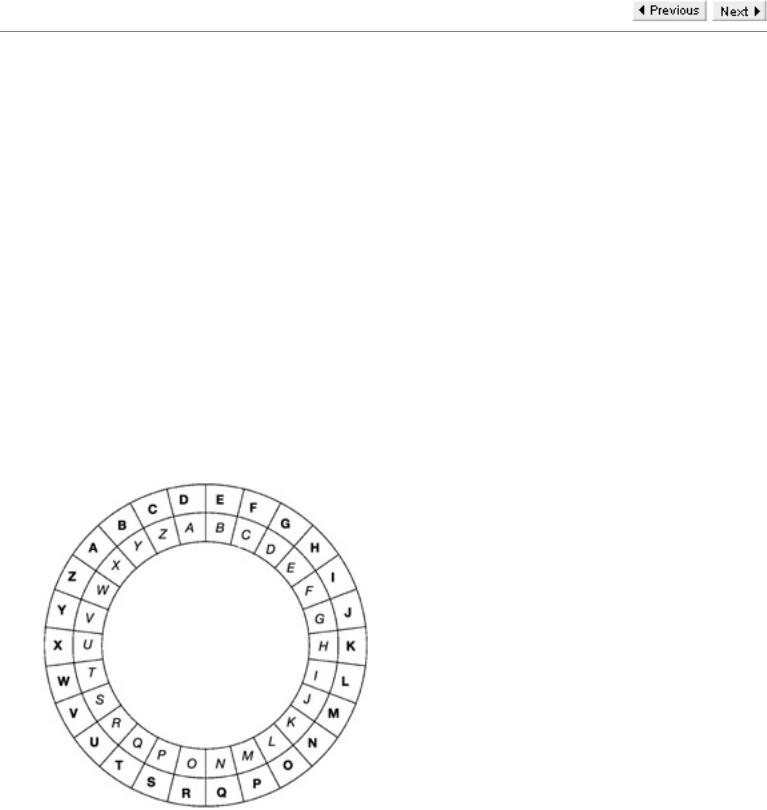
- •Table of Contents
- •BackCover
- •Cryptography-A Very Short Introduction
- •Chapter 1: Introduction
- •Using this book
- •Chapter 2: Understanding Cryptography
- •The basic concepts
- •Chapter 3: Historical Algorithms: Simple Examples
- •Caesar Cipher
- •Simple Substitution Ciphers
- •The statistics of the English language
- •The Playfair Cipher
- •Homophonic Coding
- •Polyalphabetic Ciphers
- •Vigenère Ciphers
- •Transposition Ciphers
- •Super-encryption
- •Some conclusions
- •Appendix
- •Chapter 4: Unbreakable Ciphers?
- •Perfect secrecy
- •The one-time pad
- •Chapter 5: Modern Algorithms
- •Bit-strings
- •Stream ciphers
- •Block ciphers (ECB mode)
- •Hash functions
- •Public key systems
- •Chapter 6: Practical Security
- •Realistic security
- •Practical exhaustive key searches
- •Attacks on public key systems
- •Chapter 7: Uses of Cryptography
- •Using symmetric algorithms for confidentiality
- •Authentication
- •Using symmetric algorithms for authentication and data integrity
- •Digital signatures
- •Certification authorities
- •Public Key Infrastructure
- •The need for trust
- •Chapter 8: Key Management
- •The key life cycle
- •Key hierarchies
- •Managing keys in networks
- •Using a trusted management centre
- •Key recovery and key back-up
- •Chapter 9: Cryptography in Everyday Life
- •A cash withdrawal from an ATM
- •Pretty Good Privacy (PGP)
- •Secure web browsing
- •Using a GSM mobile phone
- •References and further reading

Chapter 3: Historical Algorithms: Simple Examples
Team-Fly
Chapter 3: Historical Algorithms: Simple Examples
Introduction
In this chapter we introduce some early 'pencil and paper' examples to illustrate the basic ideas introduced in Chapter 2. We also use them
to give some insight into the type of attacks that might be launched by interceptors and illustrate some of the difficulties faced by algorithm designers. The algorithms discussed are all symmetric and were designed, and used, long before public key cryptography was proposed. The chapter is intended for a non-mathematical reader. However, there are a few occasions when we feel it is necessary to discuss the underlying mathematics, especially modular arithmetic. When this occurs the reader's understanding should not be impaired if they skip the mathematics. Nevertheless we provide a basic mathematics tutorial (in the appendix at the end of the chapter) that should be sufficient to enable all readers to understand the text if they wish.
These algorithms are outdated and not really indicative of any modern cryptographic techniques. However, it is very informative to study a number of early systems where encryption was achieved by replacing each letter by another, called letter substitution, and/or changing the order of the letters. There are a number of reasons for this. One is that they enable us to give simple, easy to understand examples that clarify the basic concepts and enable us to illustrate a number of potential weaknesses in ciphers. Another is that they are fun to play with and, since they tend to be non-mathematical, can be enjoyed by 'amateurs' with no scientific training.
Team-Fly
file:///D|/1/4303/Fly0006.html [08.10.2007 12:51:04]

Caesar Cipher
Team-Fly
Caesar Cipher
One of the earliest examples of a cipher was the Caesar Cipher described by Julius Caesar in the Gallic Wars. In this cipher each of the letters A to W is encrypted by being represented by the letter that occurs three places after it in the alphabet. The letters X, Y, Z are represented by A, B, and C respectively. Although Caesar used a 'shift' of 3, a similar effect could have been achieved using any number from 1 to 25. In fact any shift is now commonly regarded as defining a Caesar Cipher.
Once again we use a diagram to illustrate a cipher. The figure represents two concentric rings of which the outer one is free to rotate. If we start with the letter A outside A, a shift of 2 results in C being outside A and so on. Including the shift of 0 (which of course is the same as a shift of 26), there are now 26 settings. For a Caesar Cipher the encryption key and the decryption key are both determined by a shift.
Once a shift has been agreed then encryption for a Caesar Cipher is achieved by regarding each letter of the plaintext as being on the inside ring and replacing it by the letter outside it in the diagram. For decryption we merely perform the reverse operation. Thus, from the figure, for a shift of 3 the ciphertext for the plaintext message DOG is GRJ while the plaintext for a cryptogram FDW is CAT. In order to give the reader confidence that they understand the system we list four statements to check. If the shift is 7 then the ciphertext corresponding to VERY is CLYF while, for shift 17, the plaintext corresponding to JLE is SUN.
In our description of the Caesar Cipher, the encryption key and decryption key are both equal to the shift but the encryption and decryption rules are different. However, we could have changed the formulation slightly to make the two rules coincide and have different encryption and decryption keys. To see this we merely observe that a shift of 26 has the same effect as a shift of 0 and, for any shift from 0 to 25, encryption with that shift is the same as decryption with the new shift obtained by subtracting the original shift from 26. So, for example, encryption with shift 8 is the same as decryption with shift 26 - 8 = 18. This enables us to use the same rule for encryption and decryption with the decryption key 18 corresponding to the encryption key 8.
A 'machine' to implement a Caesar Cipher
We have already mentioned exhaustive key searches and clearly, since there are only 26 keys, Caesar Ciphers are vulnerable to this type of attack. Before we give an example we must point out another of their weaknesses. The key can be determined from knowledge of a single pair of corresponding plaintext and ciphertext characters. This is a very small amount of information.
The simplest way to illustrate an exhaustive key search is to work through a complete example that, since there are only 26 keys, is particularly easy for a Caesar Cipher. Let us suppose that we know that a Caesar Cipher is being used, that we anticipate a message in English, and that we intercept the cryptogram XMZVH. If the sender had used a shift of 25 for encryption then decryption would be achieved by performing a shift of 1 to give YNAWI as the message. Since this has no meaning in English we can safely eliminate 25 as the
file:///D|/1/4303/Fly0007.html (1 von 3) [08.10.2007 12:51:04]

Caesar Cipher
key value. The result of systematically trying the keys 25 to 1, in decreasing order, is shown in Table 1.
Table 1: An example of an exhaustive key search: cryptogram XMZVH |
|
|
|
|||
Enciphering |
Assumed |
Enciphering |
Assumed |
Enciphering |
|
Assumed |
key |
'message' |
key |
'message' |
key |
|
'message' |
0 |
XMZVH |
17 |
GVIEQ |
|
8 |
PERNZ |
25 |
YNAWI |
16 |
HWJFR |
|
7 |
QFSOA |
24 |
ZOBXJ |
15 |
IXKGS |
|
6 |
RGTPB |
23 |
APCYK |
14 |
JYLHT |
|
5 |
SHUQC |
22 |
BQDZL |
13 |
KZMIU |
|
4 |
TIVRD |
21 |
CREAM |
12 |
LANJV |
|
3 |
UJWSE |
20 |
DSFBN |
11 |
MBOKW |
|
2 |
VKXTF |
19 |
ETGCO |
10 |
NCPLX |
|
1 |
WLYUG |
18 |
FUHDP |
9 |
ODQMY |
|
|
|
The only English word among the 26 potential messages is CREAM and, consequently, we can deduce that the encryption key is 21. This enables us to decrypt all future messages until the key is changed. Despite the total success of this particular key search, it is important to realize that in general, for more complicated ciphers, a single key search may not identify the key uniquely. It is much more likely merely to limit the number of possibilities by eliminating some obviously wrong ones. As an illustration we revert to the Caesar Cipher and note that an exhaustive search for the encryption key for cryptogram HSPPW yields two possibilities that lead to complete English words for the assumed message. (These shifts are 4, that gives DOLLS, and 11, that gives WHEEL.)
When this happens we need more information, possibly the context of the message or some extra ciphertext, before we can determine the key uniquely. Nevertheless the result of the search does mean that we have significantly reduced the number of possible keys and that, if we do intercept a further cryptogram, we need not conduct another full key search. In fact, for this small illustration, we need only try the values 4 and 11.
There is another interesting observation resulting from this example. During its solution the reader will have found two five-letter English words such that one is obtained from the other by using a Caesar Cipher with shift of 7. You might like to pursue this further and try to find pairs of longer words, or possibly even meaningful phrases, which are shifts of each other.
From this brief illustration it should be clear that Caesar Ciphers are easy to break. Nevertheless they were successfully employed by Julius Caesar, probably because it never occurred to his enemies that he was using a cipher. Today everyone is much more aware of encryption.
The description of a Caesar Cipher using the Caesar Wheel can be replaced by a mathematical definition. We include it here, but anyone who is in any way nervous about the use of mathematical notation should skip this discussion and progress to the next section.
When introducing the Caesar Cipher we noted that a shift of 26 is the same as a shift of 0. This is because a shift of 26 is a complete revolution of the Caesar Wheel. This reasoning can be extended to show that any shift is equivalent to a shift between 0 and 25. For example a shift of 37 is obtained by one complete revolution of the Caesar Wheel and then a shift of 11. Instead of saying, for example, that a shift of 37 is equivalent to a shift of 11, we write 37 = 11 (mod 26).
This is known as using arithmetic modulo 26, and 26 is known as the modulus. Modular arithmetic, for many other moduli as well as 26, plays a crucial role in a number of cryptographic areas. Thus at the end of this chapter we include an appendix to familiarize the reader with the relevant definitions and results in this branch of elementary number theory.
Caesar Ciphers are sometimes referred to as additive ciphers. In order to appreciate why, we have only to assign integer values to the letters in the following way:
A = 0, B=1, . .. , Z = 25.
Encryption for a Caesar Cipher with shift y can now be achieved by replacing the number x by x + y (mod 26). Thus, for example, since N is the fourteenth letter of the alphabet, N= 13. To encrypt N with a shift of 15, we have x = 13, y = 15, which means the encrypted version of N is 13 + 15 = 28 = 2 (mod 26). So N is encrypted as C.
file:///D|/1/4303/Fly0007.html (2 von 3) [08.10.2007 12:51:04]

Caesar Cipher
As we have already seen, the number of keys for additive ciphers is too small. If we try to think of ways of obtaining a cipher system with a larger number of keys then we might try extending the system to include multiplication as an alternative encryption rule. However if we try this then, since encryption must be a reversible process, there is restriction on the number of 'multiplicative keys'.
Suppose we try to encrypt messages by multiplying by 2 and use arithmetic modulo 26. When we do this A and N are both encrypted as A, B and O are both encrypted as C, etc. It turns out that only those letters represented by even numbers can appear in any cryptogram and that each such cryptogram letter might represent one of two letters. This makes decryption virtually impossible and multiplication by 2 cannot be used for encryption. An even more dramatic example is trying to encrypt by multiplying by 13. In this case half the alphabet would be encrypted as A with the other half as N. In fact 1, 3, 5, 7, 9, 11, 15, 17, 19, 21, 23, or 25 are the only numbers for which multiplication can be used to provide encryption.
Team-Fly
file:///D|/1/4303/Fly0007.html (3 von 3) [08.10.2007 12:51:04]
